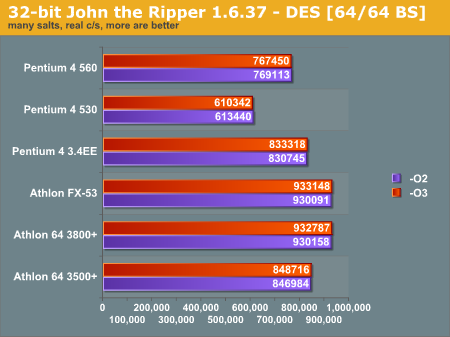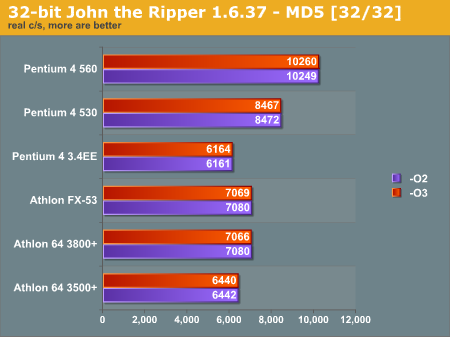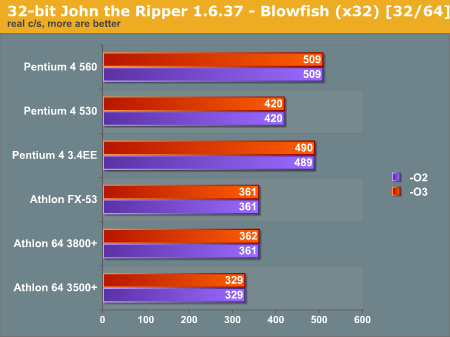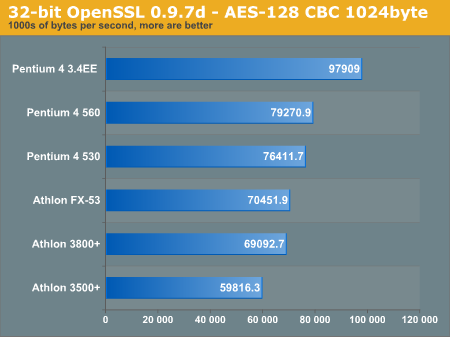Linux Desktop CPU Roundup: Cutting Edge Penguin Performance
by Kristopher Kubicki on September 19, 2004 8:00 PM EST- Posted in
- Linux
Encryption Benchmarks
Finally, our favorite part of any Linux benchmark - hashing and encryption tests. John the Ripper has multiple optimizations for Intel and AMD hardware, including hand-coded ASM functions. For the 64-bit versions of John, we compiled using the make linux-x86-64-elf target. As you can see, this produces slower binaries than the 32-bit versions of John. Oddly, the 64-bit binaries were heavily dependent on compiler flags, while the 32-bit versions showed very little difference from one compile flag to another.The Pentium 4 560 gets extremely penalized in the DES hashing, but excels in the Blowfish and MD5 benchmark. Both are still horrendously slow if you plan on using either algorithm to brute force anything, but if you tend to generate a lot of keys, you will notice a difference between the AMD and Intel CPUs.
Below, you can see how our processors performed in the OpenSSL "speed" benchmark.
OpenSSL's crypt libraries are probably heavily optimized for 64-bit operation; we see the difference in the two architectures very clearly. The RSA functionality is extremely crippled on the Pentium4 platform. Although this is an extreme example of one hardware platform dominating another, we consider this to be a relevant real world example.
An unusual problem occured while running the OpenSSL benchmark. Even though we are using Intel validated heatsink/fan combos we recieved a continuous stream of errors from the operating system regarding thermal temperatures. An example syslog can be seen below:
Message from syslogd@linux at Mon Sep 18 01:57:27 2004 ...
linux kernel: CPU#0: Temperature above threshold
This does not bode well for the processor. Our processor test bed is completely caseless, and if we have issuse with our 3.6GHz processor out of a normal case, we can't imagine what issues might exist in a full enclosure.















33 Comments
View All Comments
ravedave - Monday, September 20, 2004 - link
What klah is trying to say in too many and too big of words : Make the scale the same for the mouseover pics.Also make the picture height the same as well if possible.
Otherwise a very good article.
Has anyone thought of making an open office benchmark for linux?
klah - Monday, September 20, 2004 - link
Good article, but I have a comment on the mouse-over graphs. They work well in other articles such as the recent DVR-108D article where the scale and axes remain constant. In this case however the layout and in some cases even the scale are different between the two graphs. It would be easier to compare the two if the scale was the same and processors were in the same layout(spacing/location), with the inapplicable processors still listed to maintain the same appearance between the two.If that explanation is nonsensical I can create a few images to try to elucidate my point.
Decoder - Monday, September 20, 2004 - link
"Hold your mouse over for the 64-bit graph."I like to see the 32 and 64 bits on the same graph. Why not use Athlon FX-53 (32) and Athlon FX-53 (64) for labels?